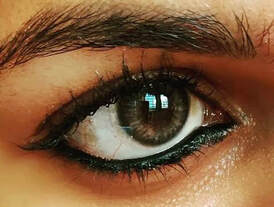Eyes are the mirror to your soul- care them

Ayurveda – The science of life not only aiming in the curative aspects of disease but also emphasising the importance of well being and how someone can maintain good health by elaborating daily routines seasonal routines etc. Dinacharya, if followed properly, helps to establish balance in an individual’s constitution and thereby helps in regulating the biological clock.
The Ayurvedic eye treatment takes a holistic approach to improve eyesight. Primarily, the eye is one of the most vital organs of the human body. Our vision plays a crucial role in our social and intellectual development.Nearly 80% of the knowledge we gain is through our eyes only.
Netra anjana is one of the special treatment done in eye disorder. Anjana is procedure of applying medicine in the form of Gutika, Raskriya or Churna to the inner side of lower lid either by fingertip or by an applicator.
MODE OF APPLICATION OF KAJAL
It should be applied from the inner canthus to the outer canthus and vice-versa on the inner part of the eye lid or on the palpebral conjunctiva by using an Anjana Shalaka or physician’s finger either in the morning time or in the evening, Kajal application is not recommended during midday when the eyes are fatigued by strong rays of sun .
After applying kajal , the eye balls should be moved up and rotated slowly, the eyelids should also be moved slight by massaging over it,by these acts the kajal spreads to all places .
INDICATIONS:
Refractive errors,Watery eyes,Dry eyes, Itching, Eye strain, Oedema of eye
CONTRAINDICATIONS
Those who have fatigue, Udavarta, excessive lacrimation, alcoholic, anger, fear, fever , suppression of natural urges and disorders of head . Also it should not be applied during the period of less sleep, in windy days , on exposure to dust and smoke , in the presence of eye discharge and Adhimantha-defective vision with pain , just after the Nasya, Vamana and Virechana ,after a head bath, during indigestion
METHOD OF PREPARATION OF AYURVEDIC KAJAL
Preparation of homemade kajal begins with dipping a clean, white, thin muslin cloth, about ten by ten centimetres square, in sandalwood paste or the juice of Alstonia scholaris (Manjal karisilanganni), which is then dried in the shade. This dip and dry process is done all day long. After sunset, a wick is made out of the cloth, which is then used to light a mud lamp filled with castor oil. A brass vessel is kept over the lamp, leaving a little gap, just enough for the oxygen to aid the burning of the lamp. This is left burning overnight. In the morning, one or two drops of pure ghee or castor oil are added to the soot which now lines the brass vessel. It is then stored in a clean dry box.


